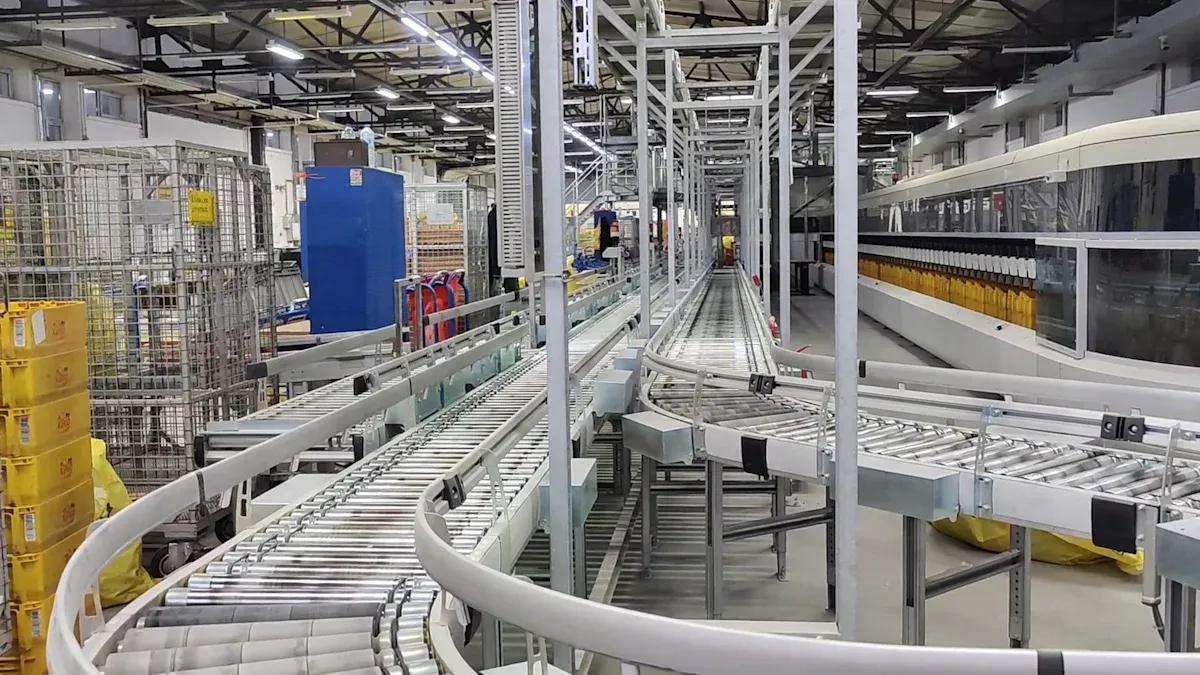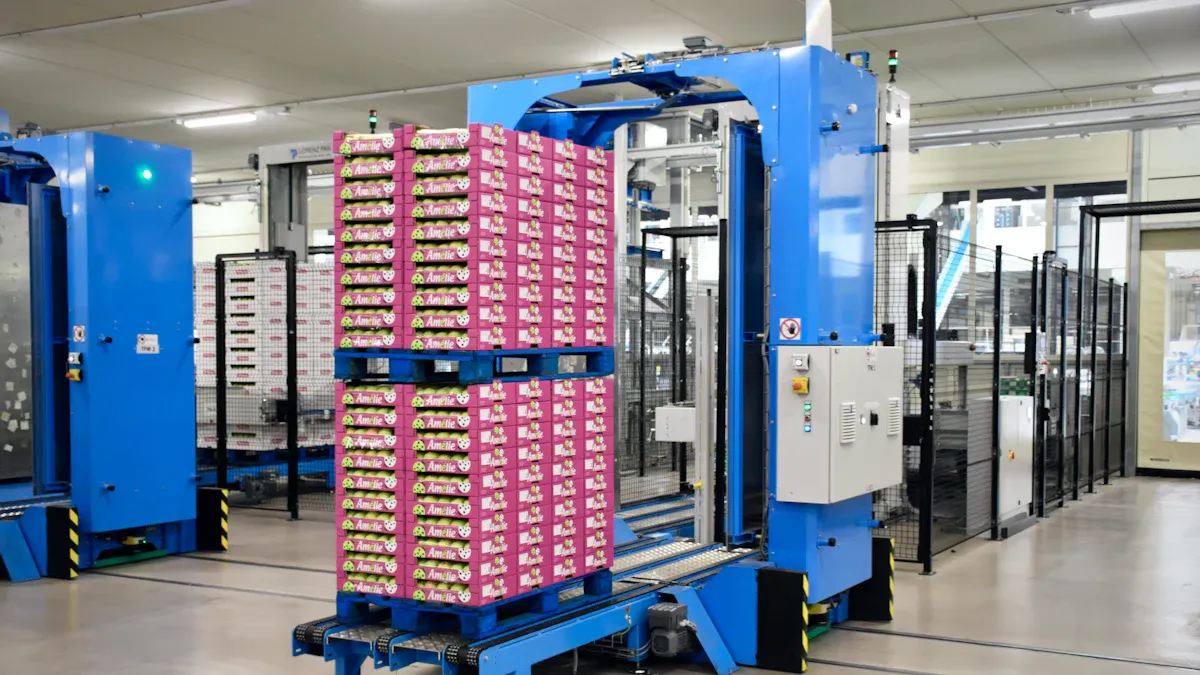Unlocking the Potential of WMS with Automated Testing

Warehouse management systems (WMS) thrive on precision and efficiency, but maintaining these standards can be challenging. Automated testing plays a pivotal role in overcoming these hurdles. By simulating real-world scenarios, it identifies bottlenecks, optimizes performance, and ensures systems handle increased data loads seamlessly. For instance, performance testing on a custom WMS revealed critical weaknesses, enabling swift improvements. This approach not only boosts efficiency but also reduces risks. Whether driving innovation or safeguarding stability, automated testing combines offensive and defensive strategies to unlock the full potential of WMS.
Key Takeaways
Automated testing saves time by doing tasks faster than people can.
It improves accuracy by removing mistakes made by humans.
This makes sure every part of the WMS is checked well.
Automated testing finds problems early, lowering risks and keeping customers happy.
It helps businesses grow by spotting slowdowns and handling more work.
Regular testing checks updates and keeps the system steady.
This stops big problems and keeps things running smoothly.
The Role of Automated Testing in WMS

Defining Automated Testing
Automated testing uses specialized software tools to run tests without human intervention. It ensures consistency by executing pre-written scripts that mimic user actions. This process validates assumptions about data and system behavior, confirming that everything works as expected. By automating repetitive tasks, it saves time and reduces errors. Think of it as having a tireless assistant that checks every detail, ensuring nothing slips through the cracks.
In the context of technology, automated testing plays a critical role in maintaining software reliability. It confirms that data states and query results align with expectations, boosting confidence in the system's integrity. This approach is especially valuable for complex systems like warehouse management systems (WMS), where accuracy is non-negotiable.
Relevance of Automated Testing to WMS
Warehouse management systems handle a wide range of tasks, from inventory tracking to order fulfillment. These systems must operate flawlessly to avoid disruptions. Automated testing ensures that every component of a WMS functions as intended. It identifies potential issues before they escalate, keeping operations smooth and efficient.
For WMS, automated testing is more than just a quality check. It supports scalability by ensuring the system can handle increased workloads. It also facilitates the integration of new features, allowing businesses to adapt to changing demands. In short, automated testing is the backbone of a reliable and future-ready WMS.
Benefits of Automated Testing in WMS
Boosting Efficiency and Speed
Automated testing accelerates the testing process. Tasks that would take hours manually can be completed in minutes. This speed allows businesses to roll out updates and improvements faster, staying ahead of the competition. For WMS, this means quicker adaptation to market changes and customer needs.
Enhancing Accuracy and Quality
Manual testing is prone to human error. Automated testing eliminates this risk by following precise scripts. It ensures that every aspect of the WMS is thoroughly checked, leaving no room for oversight. This level of accuracy translates to higher-quality performance and fewer disruptions.
Minimizing Operational Risks
By catching issues early, automated testing reduces the likelihood of system failures. It acts as a safety net, identifying vulnerabilities before they impact operations. For WMS, this means fewer delays, happier customers, and a stronger bottom line.
Offensive Strategies with Automated Testing
Driving Scalability and Innovation
Preparing for Future Growth
Warehouse management systems must evolve to handle increasing demands. Automated testing plays a key role in preparing for this growth. By simulating real-world scenarios, it identifies bottlenecks that could hinder scalability. For example, performance testing evaluates how a WMS handles higher data loads and user activity. This proactive approach ensures the system remains efficient as operations expand. Businesses can confidently scale their operations, knowing their WMS is ready for the challenge.
Seamless Integration of New Features
Innovation often requires adding new features to existing systems. Automated testing ensures these updates integrate smoothly without disrupting current operations. Regular testing uncovers weaknesses in the supply chain, allowing developers to address them before deployment. This process fosters innovation by enabling businesses to adapt quickly to market changes. With automated testing, companies can introduce new capabilities while maintaining system stability.
Supporting Continuous Improvement
Agile Development in WMS
Agile development thrives on flexibility and rapid iteration. Automated testing supports this approach by providing quick feedback on system changes. Developers can test new features or updates in real-time, ensuring they align with business goals. This iterative process keeps WMS solutions dynamic and responsive to evolving needs.
Identifying Optimization Opportunities
Automated testing doesn’t just find problems—it highlights opportunities for improvement. Continuous analysis of system performance reveals areas where efficiency can be enhanced. For instance, testing might uncover slow query responses or inefficient workflows. Addressing these issues boosts overall productivity and keeps the WMS running at peak performance.
Best Practices for Offensive Automated Testing
Choosing the Right Tools for Innovation
Selecting the right tools is crucial for effective automated testing. Tools should align with the specific needs of the WMS, such as handling large datasets or simulating complex workflows. Investing in versatile and scalable tools ensures the system can adapt to future challenges.
Establishing Continuous Feedback Loops
Feedback is the backbone of continuous improvement. Automated testing should integrate with feedback loops that provide actionable insights. These loops help teams monitor system performance and make informed decisions. A well-structured feedback system ensures the WMS evolves alongside business requirements.
Tip: Regularly review testing strategies to ensure they align with long-term goals. This practice keeps offensive testing efforts focused and effective.
Defensive Strategies with Automated Testing
Ensuring System Stability
Early Bug Detection and Resolution
System stability is the backbone of any warehouse management system (WMS). Early bug detection ensures that potential issues are addressed before they disrupt operations. Automated testing excels at identifying these bugs by running repetitive and thorough checks. For example, it can simulate various user interactions to uncover hidden glitches. This proactive approach saves time and prevents costly downtime. Businesses can rely on automated testing to maintain smooth workflows and avoid unexpected surprises.
Validating Updates and Patches
Every update or patch introduces changes to a WMS. Without proper validation, these changes might cause unintended consequences. Automated testing ensures that updates integrate seamlessly with existing systems. It verifies that new patches don’t interfere with critical functions. By validating updates, businesses can confidently roll out improvements without compromising system stability.
Mitigating Downtime Risks
Stress Testing for Peak Performance
Downtime can be a nightmare for any business. Stress testing helps mitigate this risk by pushing the WMS to its limits. Automated testing simulates high-traffic scenarios to evaluate how the system performs under pressure. This process identifies weak points that could lead to crashes during peak periods. By addressing these vulnerabilities, businesses can ensure their WMS remains reliable even during the busiest times.
Monitoring Security Vulnerabilities
Security is a top priority for any WMS. Automated testing plays a crucial role in identifying vulnerabilities that hackers might exploit. It scans for weak points in the system, such as outdated protocols or unsecured data paths. Regular security testing helps businesses stay one step ahead of potential threats. A secure WMS not only protects sensitive data but also builds trust with customers.
Best Practices for Defensive Automated Testing
Prioritizing Critical System Components
Not all parts of a WMS are equally important. Defensive testing should focus on the most critical components first. For instance, inventory tracking and order processing modules often require extra attention. By prioritizing these areas, businesses can ensure that essential functions remain operational at all times.
Automating Regression Testing
Regression testing ensures that new changes don’t break existing features. Automating this process saves time and improves accuracy. Automated regression tests can quickly verify that updates haven’t introduced new issues. This practice keeps the WMS stable and reliable, even as it evolves.
Tip: Schedule regular automated tests to catch issues early and maintain system stability.
Real-World Applications of Automated Testing in WMS

Case Study: Scaling Operations with Offensive Testing
Automated testing has proven invaluable for businesses aiming to scale their warehouse operations. A major e-commerce company implemented a continuous integration and continuous delivery (CI/CD) pipeline to streamline its WMS updates. This approach reduced deployment time by 70% and significantly decreased production issues. By automating repetitive testing tasks, the company ensured its system could handle increased data loads and user activity without compromising performance.
Another example comes from a webcast by Cycle Labs and enVista, which highlighted how test automation enhances agility in warehouse operations. Automated testing allowed businesses to identify bottlenecks early, ensuring smooth scalability. These real-world applications demonstrate how offensive testing strategies prepare WMS for future growth and innovation.
Case Study: Preventing Downtime with Defensive Testing
Defensive testing focuses on maintaining system stability and preventing costly downtime. Performance testing plays a critical role here. By simulating real-world scenarios, businesses can assess how their WMS handles increased data loads during peak periods. This process identifies bottlenecks and weaknesses before they disrupt operations.
Continuous automated performance testing ensures that the WMS remains efficient and reliable, even during high-demand situations. For example, stress testing evaluates how the system performs under pressure, helping businesses address vulnerabilities proactively. These strategies not only prevent downtime but also protect customer satisfaction and operational efficiency.
Key Takeaways from Industry Leaders
Industry leaders emphasize the importance of automated testing in achieving operational excellence. Metrics like order accuracy and inventory turnover highlight its impact. The average order accuracy rate across industries is 96.3%. Businesses exceeding this benchmark can improve customer retention and reduce costly returns. Additionally, higher inventory turnover reflects faster product movement, which boosts overall efficiency.
Automated testing supports these goals by ensuring system reliability and identifying optimization opportunities. By adopting best practices, businesses can unlock the full potential of their WMS and stay ahead in a competitive market.
Automated testing has become a cornerstone for optimizing warehouse management systems. It identifies bottlenecks, simulates real-world scenarios, and ensures systems handle increased loads effectively. By combining offensive strategies like scalability with defensive measures like stress testing, businesses can achieve both innovation and stability. This dual approach keeps operations efficient and secure, even during updates or infrastructure changes. Adopting automated testing empowers organizations to stay competitive, adapt to market demands, and unlock their WMS's full potential. Why wait? Start leveraging its benefits today.
FAQ
What is automated testing, and why is it important for WMS?
Automated testing uses software tools to test systems without manual effort. It ensures WMS runs smoothly by identifying bugs, validating updates, and improving performance. This process saves time, reduces errors, and keeps operations efficient. Think of it as a digital safety net for your warehouse system. 🛠️
How does automated testing improve WMS scalability?
Automated testing prepares WMS for growth by simulating high-demand scenarios. It identifies bottlenecks and ensures the system can handle increased workloads. Businesses can confidently expand operations, knowing their WMS is ready for future challenges. Scalability becomes seamless with this proactive approach.
Can automated testing help prevent downtime?
Absolutely! Automated testing detects vulnerabilities before they cause disruptions. Stress tests simulate peak traffic to ensure the system performs under pressure. By addressing weak points early, businesses avoid costly downtime and maintain smooth operations. It’s like having a 24/7 watchdog for your WMS. 🕒
What tools are best for automated testing in WMS?
The best tools depend on your WMS needs. Look for ones that handle large datasets, simulate workflows, and integrate with your existing system. Popular options include Selenium, TestComplete, and Katalon Studio. Choose tools that align with your goals for innovation and stability.
How often should automated testing be performed?
Frequent testing is key to maintaining a reliable WMS. Schedule tests after updates, during peak seasons, or when introducing new features. Regular testing ensures the system stays efficient and secure. A consistent schedule keeps operations running like clockwork. ⏰
Tip: Set automated reminders to stay on top of your testing schedule!
See Also
Maximizing Opportunities Within Your Automotive Supply Network
Exploring AI's Hidden Capabilities in Logistics Management
Enhancing Warehouse Operations Through Robotic Automation Insights
The Importance of Warehouse Automation for Business Success
Discovering Efficiency Through JUSDA's Latest Warehousing Innovations
